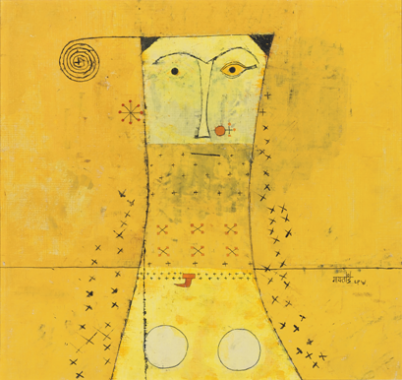From October 3, 2015–January 10, 2016, the Peggy Guggenheim Collection, Venice, presents V. S. Gaitonde: Painting as Process, Painting as Life. Comprising over 40 major paintings and works on paper drawn from public institutions and private collections across Asia, Europe, and the United States, this is the first retrospective exhibition dedicated to the work of celebrated Indian modern painter Vasudeo Santu Gaitonde (1924–2001). As current scholarship revisits traditions of mid-twentieth-century modern art outside the Euro-American paradigm, Gaitonde’s work presents an unparalleled opportunity to explore Indian modern art as it played out in the metropolitan centers of Bombay (now Mumbai) and New Delhi from the late 1940s through the end of the twentieth century. Venice is the second venue of this exhibition, which was previously presented at the Solomon R. Guggenheim Museum, New York (October 24, 2014–February 11, 2015).
V. S. Gaitonde was known to fellow Indian artists and intellectuals, as well as to later generations of students and admirers, as a man of uncompromising integrity of spirit and purpose. Born in Nagpur, India, Gaitonde was briefly affiliated with avant-garde collectives in Bombay in the early 1950s, but remained an independent practitioner throughout most of his career. This exhibition draws an arc from Gaitonde’s early figurative, mixed-medium compositions and watercolors inspired by Paul Klee, through his major bodies of signature canvases of the ’60s and ’70s, to his late works of the ’80s and ’90s. Departing from Klee, Gaitonde’s oeuvre began in the late ’50s in a nonrepresentational mode—or, as he preferred to call it, a nonobjective style. This turn towards abstraction echoes the artistic principles first espoused by Vasily Kandinsky and later embodied by the Guggenheim with its origins as the Museum of Non-Objective Painting. This turn also dovetails with Gaitonde’s lifelong interest in Zen Buddhism and his adoption of its ethics in his life and creative practice.
Short, stocky, self-critical, and confident, Gaitonde scorned sentimentality in his biography and his artistic practice. As fellow painter Krishen Khanna has stated, “There’s a very strong correlation I see between the way Gaitonde thought, the way he lived, and the way he painted.” Alongside art, Gaitonde was an avid admirer of vernacular Indian poetry, world cinema, literature, theater, Western classical music, and systems of Eastern philosophical thought. Stressing the importance of the present moment, the completeness and joy of the creative process, and the intimate relationship between painter and painting, “Gai” as he was popularly known among peers, was an intrepid and influential artist whose career remains unequaled in the history of South Asian modern art. Yet Gaitonde remains sorely understudied in the genealogies of twentieth-century world art.
Including many works that have not been seen by the public, this exhibition reveals Gaitonde’s extraordinary use of color, line, form, and texture, as well as symbolic elements and calligraphy, in works that glow with an inner light. The artist often spent months conceiving a new composition, but allowed accident and play ultimately to inform the making of his art. Starting in the early ’60s, he employed palette knives and paint rollers, and later torn pieces of newspaper and magazines, to create abstract forms through a “lift-off” technique. The resulting paintings have a sense of weightlessness, though their texture asserts physicality and presence. In the mid ’60s, Gaitonde traveled to New York as part of a Rockefeller-funded grant, at which time photographer Bruce Frisch captured the artist working in his studio at the Chelsea Hotel in January 1965. A selection of these rarely seen historic images will be presented at the Peggy Guggenheim Collection as part of the exhibition, in digitized form.
A transnational set of references and influences provides an art historical context for Gaitonde’s work and defines this exhibition. The artist’s work spans the traditions of nonobjective painting and Zen Buddhism as well as Indian miniatures, East Asian hanging scrolls, and ink paintings. A man of his tumultuous times, one can also draw parallels to artists working within the contemporary School of Paris, as well as movements such as Art Informel, Tachisme, and Abstract Expressionism elsewhere in the world. Gaitonde’s output, however, continues to be defined by the particular ethos of India, where the artist lived and worked his entire life.
The exhibition is accompanied by a scholarly catalogue authored by Sandhini Poddar that serves as the first comprehensive art historical and biographic record of the artist.

